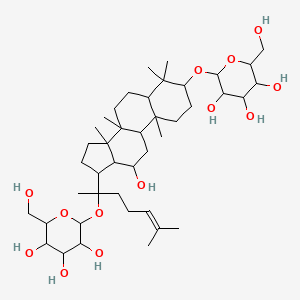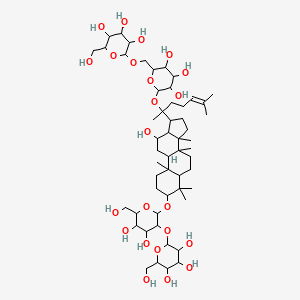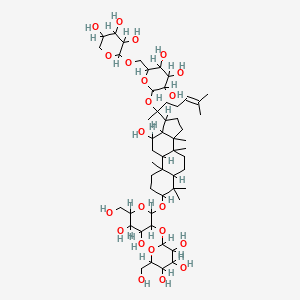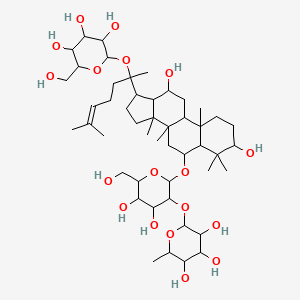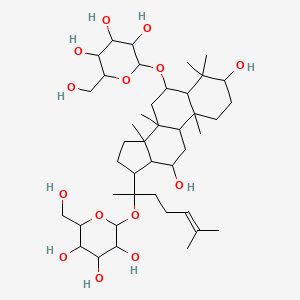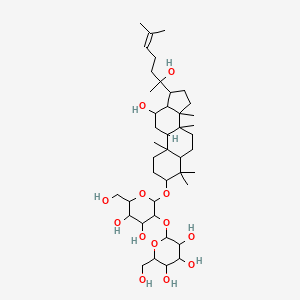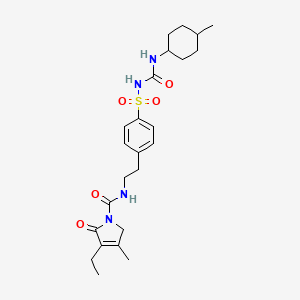
Glimepirid
Übersicht
Beschreibung
Glimepirid ist ein Antidiabetikum aus der Klasse der Sulfonylharnstoffe, das hauptsächlich zur Behandlung von Typ-2-Diabetes mellitus verschrieben wird. Es gilt als Zweitlinienoption im Vergleich zu Metformin, da Metformin eine gut etablierte Sicherheit und Wirksamkeit aufweist . This compound wirkt in erster Linie durch die Steigerung der Insulinproduktion in der Bauchspeicheldrüse . Es wurde 1979 patentiert und 1995 für die medizinische Anwendung zugelassen .
Wirkmechanismus
Target of Action
Glimepiride, a second-generation sulfonylurea drug, primarily targets the pancreatic beta cells . These cells play a crucial role in the regulation of blood glucose levels by secreting insulin, a hormone that facilitates the uptake of glucose into cells .
Mode of Action
Glimepiride stimulates the secretion of insulin granules from pancreatic islet beta cells by blocking ATP-sensitive potassium channels (KATP channels) and causing depolarization of the beta cells . This action results in an increase in insulin levels, which in turn promotes the uptake of glucose into cells, thereby lowering blood glucose levels .
Biochemical Pathways
The primary biochemical pathway affected by glimepiride is the insulin signaling pathway. By stimulating the release of insulin, glimepiride enhances the insulin-mediated peripheral glucose uptake . This leads to a decrease in blood glucose levels, which is the primary goal in the management of type 2 diabetes mellitus .
Pharmacokinetics
Glimepiride exhibits excellent pharmacokinetic properties. It is completely absorbed after oral administration, with peak plasma concentrations reached within 2 to 3 hours . It has a high protein binding rate of over 99.5% . Glimepiride is metabolized in the liver through the CYP2C9 enzyme and has an elimination half-life of 5-8 hours . It is excreted in urine (~60%) and feces (~40%) . These properties contribute to its once-daily dosing regimen .
Result of Action
The primary molecular effect of glimepiride is the increased secretion of insulin from pancreatic beta cells . On a cellular level, this leads to an increase in the uptake of glucose into cells, resulting in a decrease in blood glucose levels . Glimepiride has been associated with a lower risk of developing hypoglycemia and weight gain in clinical trials, as well as fewer cardiovascular effects than other sulfonylureas due to minimal effects on ischemic preconditioning of cardiac myocytes .
Action Environment
The efficacy and stability of glimepiride can be influenced by various environmental factors. For instance, lifestyle modifications such as diet and exercise are recommended in conjunction with the use of glimepiride for optimal glycemic control . Furthermore, the presence of adequate insulin synthesis is a prerequisite for the effective action of glimepiride .
Wissenschaftliche Forschungsanwendungen
Glimepiride has a wide range of scientific research applications:
Biochemische Analyse
Biochemical Properties
Glimepiride stimulates insulin release from pancreatic β-cells and may act via extrapancreatic mechanisms . It is administered once daily to patients with type 2 diabetes mellitus in whom glycemic control is not achieved by diet and exercise alone .
Cellular Effects
Glimepiride lowers blood glucose by stimulating insulin secretions from functioning pancreatic beta cells and by inducing extra-pancreatic effects, thereby decreasing insulin resistance . It potentially binds to ATP-sensitive potassium channel receptors on the pancreatic beta cell surface, causing depolarization of the membrane which stimulates calcium ion influx through voltage-sensitive calcium channels .
Molecular Mechanism
The increase in intracellular calcium ion concentration induced by Glimepiride triggers the secretion of insulin . Glimepiride attaches itself to receptors on the surface of pancreatic ß-cells that are dependent on adenosine triphosphate (ATP). Insulin release, a calcium influx, and potassium outflow result from the closure of these channels and membrane depolarization .
Temporal Effects in Laboratory Settings
A new crystalline form of Glimepiride has been synthesized and characterized, showing different solubility and melting properties from the reported polymorphs . The crystal structure of this new form is more thermodynamically stable than the previously reported forms .
Dosage Effects in Animal Models
Specific dosage effects of Glimepiride in animal models are not mentioned in the available literature. Like other sulfonylureas, Glimepiride is used based on its well-established glucose-lowering action .
Metabolic Pathways
Glimepiride is involved in the metabolic pathway that regulates blood glucose levels. It stimulates insulin release from pancreatic β-cells, which plays a crucial role in glucose metabolism .
Vorbereitungsmethoden
Syntheserouten und Reaktionsbedingungen
Glimepirid wird durch einen mehrstufigen Prozess synthetisiert, der mehrere Zwischenprodukte beinhaltet. Die wichtigsten Schritte umfassen die Bildung des Pyrrolrings und die Anlagerung der Sulfonylharnstoffgruppe. Die Reaktionsbedingungen beinhalten typischerweise die Verwendung organischer Lösungsmittel, Katalysatoren und kontrollierter Temperaturen, um die gewünschten chemischen Umwandlungen sicherzustellen .
Industrielle Produktionsmethoden
Die industrielle Produktion von this compound beinhaltet die großtechnische Synthese unter optimierten Reaktionsbedingungen, um die Ausbeute und Reinheit zu maximieren. Der Prozess umfasst Reinigungsschritte wie Kristallisation und Filtration, um das Endprodukt in einer für die pharmazeutische Verwendung geeigneten Form zu erhalten .
Chemische Reaktionsanalyse
Arten von Reaktionen
This compound unterliegt verschiedenen chemischen Reaktionen, darunter:
Oxidation: Beinhaltet die Zugabe von Sauerstoff oder die Entfernung von Wasserstoff.
Reduktion: Beinhaltet die Zugabe von Wasserstoff oder die Entfernung von Sauerstoff.
Substitution: Beinhaltet den Austausch einer funktionellen Gruppe durch eine andere.
Häufige Reagenzien und Bedingungen
Häufige Reagenzien, die bei diesen Reaktionen verwendet werden, umfassen Oxidationsmittel wie Kaliumpermanganat, Reduktionsmittel wie Natriumborhydrid und verschiedene Katalysatoren, um die Reaktionen zu erleichtern .
Hauptprodukte, die gebildet werden
Die Hauptprodukte, die aus diesen Reaktionen entstehen, hängen von den spezifischen Bedingungen und Reagenzien ab, die verwendet werden. Zum Beispiel kann die Oxidation von this compound zur Bildung von Sulfoxiden oder Sulfonen führen .
Wissenschaftliche Forschungsanwendungen
This compound hat eine breite Palette an wissenschaftlichen Forschungsanwendungen:
Biologie: Untersucht auf seine Auswirkungen auf zelluläre Prozesse und die Insulinsekretion.
Industrie: Wird bei der Entwicklung neuer pharmazeutischer Formulierungen und Wirkstofffreisetzungssysteme verwendet.
Wirkmechanismus
This compound wirkt als Insulinstimulans. Es stimuliert die Freisetzung von Insulin aus den Betazellen der Bauchspeicheldrüse, indem es ATP-sensitive Kaliumkanäle blockiert, was zu einer Depolarisation der Betazellen und einer anschließenden Insulinsekretion führt . Zusätzlich erhöht es die Aktivität intrazellulärer Insulinrezeptoren und verstärkt die Reaktion des Körpers auf Insulin .
Analyse Chemischer Reaktionen
Types of Reactions
Glimepiride undergoes various chemical reactions, including:
Oxidation: Involves the addition of oxygen or the removal of hydrogen.
Reduction: Involves the addition of hydrogen or the removal of oxygen.
Substitution: Involves the replacement of one functional group with another.
Common Reagents and Conditions
Common reagents used in these reactions include oxidizing agents like potassium permanganate, reducing agents like sodium borohydride, and various catalysts to facilitate the reactions .
Major Products Formed
The major products formed from these reactions depend on the specific conditions and reagents used. For example, oxidation of glimepiride can lead to the formation of sulfoxides or sulfones .
Vergleich Mit ähnlichen Verbindungen
Ähnliche Verbindungen
- Glipizid
- Glyburid
- Metformin
- Semaglutid
Einzigartigkeit
Glimepirid ist unter den Sulfonylharnstoffen einzigartig, da es eine längere Wirkungsdauer und ein geringeres Risiko für Hypoglykämie im Vergleich zu anderen Sulfonylharnstoffen der zweiten Generation aufweist . Es hat auch weniger kardiovaskuläre Auswirkungen, was es zu einer sichereren Option für Patienten mit kardiovaskulären Problemen macht .
Eigenschaften
IUPAC Name |
4-ethyl-3-methyl-N-[2-[4-[(4-methylcyclohexyl)carbamoylsulfamoyl]phenyl]ethyl]-5-oxo-2H-pyrrole-1-carboxamide | |
|---|---|---|
| Source | PubChem | |
| URL | https://pubchem.ncbi.nlm.nih.gov | |
| Description | Data deposited in or computed by PubChem | |
InChI |
InChI=1S/C24H34N4O5S/c1-4-21-17(3)15-28(22(21)29)24(31)25-14-13-18-7-11-20(12-8-18)34(32,33)27-23(30)26-19-9-5-16(2)6-10-19/h7-8,11-12,16,19H,4-6,9-10,13-15H2,1-3H3,(H,25,31)(H2,26,27,30) | |
| Source | PubChem | |
| URL | https://pubchem.ncbi.nlm.nih.gov | |
| Description | Data deposited in or computed by PubChem | |
InChI Key |
WIGIZIANZCJQQY-UHFFFAOYSA-N | |
| Source | PubChem | |
| URL | https://pubchem.ncbi.nlm.nih.gov | |
| Description | Data deposited in or computed by PubChem | |
Canonical SMILES |
CCC1=C(CN(C1=O)C(=O)NCCC2=CC=C(C=C2)S(=O)(=O)NC(=O)NC3CCC(CC3)C)C | |
| Source | PubChem | |
| URL | https://pubchem.ncbi.nlm.nih.gov | |
| Description | Data deposited in or computed by PubChem | |
Molecular Formula |
C24H34N4O5S | |
| Source | PubChem | |
| URL | https://pubchem.ncbi.nlm.nih.gov | |
| Description | Data deposited in or computed by PubChem | |
DSSTOX Substance ID |
DTXSID5040675, DTXSID20861130 | |
| Record name | Glimepiride | |
| Source | EPA DSSTox | |
| URL | https://comptox.epa.gov/dashboard/DTXSID5040675 | |
| Description | DSSTox provides a high quality public chemistry resource for supporting improved predictive toxicology. | |
| Record name | 3-Ethyl-2,5-dihydro-4-methyl-N-[2-[4-[[[[(4-methylcyclohexyl)amino]carbonyl]amino]sulfonyl]phenyl]ethyl]-2-oxo-1H-pyrrole-1-carboxamide | |
| Source | EPA DSSTox | |
| URL | https://comptox.epa.gov/dashboard/DTXSID20861130 | |
| Description | DSSTox provides a high quality public chemistry resource for supporting improved predictive toxicology. | |
Molecular Weight |
490.6 g/mol | |
| Source | PubChem | |
| URL | https://pubchem.ncbi.nlm.nih.gov | |
| Description | Data deposited in or computed by PubChem | |
Physical Description |
Solid | |
| Record name | Glimepiride | |
| Source | Human Metabolome Database (HMDB) | |
| URL | http://www.hmdb.ca/metabolites/HMDB0014367 | |
| Description | The Human Metabolome Database (HMDB) is a freely available electronic database containing detailed information about small molecule metabolites found in the human body. | |
| Explanation | HMDB is offered to the public as a freely available resource. Use and re-distribution of the data, in whole or in part, for commercial purposes requires explicit permission of the authors and explicit acknowledgment of the source material (HMDB) and the original publication (see the HMDB citing page). We ask that users who download significant portions of the database cite the HMDB paper in any resulting publications. | |
Solubility |
>73.6 [ug/mL] (The mean of the results at pH 7.4), Partly miscible, 3.84e-02 g/L | |
| Record name | SID49648856 | |
| Source | Burnham Center for Chemical Genomics | |
| URL | https://pubchem.ncbi.nlm.nih.gov/bioassay/1996#section=Data-Table | |
| Description | Aqueous solubility in buffer at pH 7.4 | |
| Record name | Glimepiride | |
| Source | DrugBank | |
| URL | https://www.drugbank.ca/drugs/DB00222 | |
| Description | The DrugBank database is a unique bioinformatics and cheminformatics resource that combines detailed drug (i.e. chemical, pharmacological and pharmaceutical) data with comprehensive drug target (i.e. sequence, structure, and pathway) information. | |
| Explanation | Creative Common's Attribution-NonCommercial 4.0 International License (http://creativecommons.org/licenses/by-nc/4.0/legalcode) | |
| Record name | Glimepiride | |
| Source | Human Metabolome Database (HMDB) | |
| URL | http://www.hmdb.ca/metabolites/HMDB0014367 | |
| Description | The Human Metabolome Database (HMDB) is a freely available electronic database containing detailed information about small molecule metabolites found in the human body. | |
| Explanation | HMDB is offered to the public as a freely available resource. Use and re-distribution of the data, in whole or in part, for commercial purposes requires explicit permission of the authors and explicit acknowledgment of the source material (HMDB) and the original publication (see the HMDB citing page). We ask that users who download significant portions of the database cite the HMDB paper in any resulting publications. | |
Mechanism of Action |
ATP-sensitive potassium channels on pancreatic beta cells that are gated by intracellular ATP and ADP. The hetero-octomeric complex of the channel is composed of four pore-forming Kir6.2 subunits and four regulatory sulfonylurea receptor (SUR) subunits. Alternative splicing allows the formation of channels composed of varying subunit isoforms expressed at different concentrations in different tissues. In pancreatic beta cells, ATP-sensitive potassium channels play a role as essential metabolic sensors and regulators that couple membrane excitability with glucose-stimulated insulin secretion (GSIS). When there is a decrease in the ATP:ADP ratio, the channels are activated and open, leading to K+ efflux from the cell, membrane hyperpolarization, and suppression of insulin secretion. In contrast, increased uptake of glucose into the cell leads to elevated intracellular ATP:ADP ratio, leading to the closure of channels and membrane depolarization. Depolarization leads to activation and opening of the voltage-dependent Ca2+ channels and consequently an influx of calcium ions into the cell. Elevated intracellular calcium levels causes the contraction of the filaments of actomyosin responsible for the exocytosis of insulin granules stored in vesicles. Glimepiride blocks the ATP-sensitive potassium channel by binding non-specifically to the B sites of both sulfonylurea receptor-1 (SUR1) and sulfonylurea receptor-2A (SUR2A) subunits as well as the A site of SUR1 subunit of the channel to promote insulin secretion from the beta cell. | |
| Record name | Glimepiride | |
| Source | DrugBank | |
| URL | https://www.drugbank.ca/drugs/DB00222 | |
| Description | The DrugBank database is a unique bioinformatics and cheminformatics resource that combines detailed drug (i.e. chemical, pharmacological and pharmaceutical) data with comprehensive drug target (i.e. sequence, structure, and pathway) information. | |
| Explanation | Creative Common's Attribution-NonCommercial 4.0 International License (http://creativecommons.org/licenses/by-nc/4.0/legalcode) | |
CAS No. |
261361-60-8, 93479-97-1, 684286-46-2 | |
| Record name | 3-Ethyl-2,5-dihydro-4-methyl-N-[2-[4-[[[[(4-methylcyclohexyl)amino]carbonyl]amino]sulfonyl]phenyl]ethyl]-2-oxo-1H-pyrrole-1-carboxamide | |
| Source | CAS Common Chemistry | |
| URL | https://commonchemistry.cas.org/detail?cas_rn=261361-60-8 | |
| Description | CAS Common Chemistry is an open community resource for accessing chemical information. Nearly 500,000 chemical substances from CAS REGISTRY cover areas of community interest, including common and frequently regulated chemicals, and those relevant to high school and undergraduate chemistry classes. This chemical information, curated by our expert scientists, is provided in alignment with our mission as a division of the American Chemical Society. | |
| Explanation | The data from CAS Common Chemistry is provided under a CC-BY-NC 4.0 license, unless otherwise stated. | |
| Record name | Glimepiride [USAN:USP:INN:BAN] | |
| Source | ChemIDplus | |
| URL | https://pubchem.ncbi.nlm.nih.gov/substance/?source=chemidplus&sourceid=0093479971 | |
| Description | ChemIDplus is a free, web search system that provides access to the structure and nomenclature authority files used for the identification of chemical substances cited in National Library of Medicine (NLM) databases, including the TOXNET system. | |
| Record name | Glimepiride, cis- | |
| Source | ChemIDplus | |
| URL | https://pubchem.ncbi.nlm.nih.gov/substance/?source=chemidplus&sourceid=0684286462 | |
| Description | ChemIDplus is a free, web search system that provides access to the structure and nomenclature authority files used for the identification of chemical substances cited in National Library of Medicine (NLM) databases, including the TOXNET system. | |
| Record name | Glimepiride | |
| Source | DrugBank | |
| URL | https://www.drugbank.ca/drugs/DB00222 | |
| Description | The DrugBank database is a unique bioinformatics and cheminformatics resource that combines detailed drug (i.e. chemical, pharmacological and pharmaceutical) data with comprehensive drug target (i.e. sequence, structure, and pathway) information. | |
| Explanation | Creative Common's Attribution-NonCommercial 4.0 International License (http://creativecommons.org/licenses/by-nc/4.0/legalcode) | |
| Record name | glimepiride | |
| Source | DTP/NCI | |
| URL | https://dtp.cancer.gov/dtpstandard/servlet/dwindex?searchtype=NSC&outputformat=html&searchlist=759809 | |
| Description | The NCI Development Therapeutics Program (DTP) provides services and resources to the academic and private-sector research communities worldwide to facilitate the discovery and development of new cancer therapeutic agents. | |
| Explanation | Unless otherwise indicated, all text within NCI products is free of copyright and may be reused without our permission. Credit the National Cancer Institute as the source. | |
| Record name | Glimepiride | |
| Source | EPA DSSTox | |
| URL | https://comptox.epa.gov/dashboard/DTXSID5040675 | |
| Description | DSSTox provides a high quality public chemistry resource for supporting improved predictive toxicology. | |
| Record name | 3-Ethyl-2,5-dihydro-4-methyl-N-[2-[4-[[[[(4-methylcyclohexyl)amino]carbonyl]amino]sulfonyl]phenyl]ethyl]-2-oxo-1H-pyrrole-1-carboxamide | |
| Source | EPA DSSTox | |
| URL | https://comptox.epa.gov/dashboard/DTXSID20861130 | |
| Description | DSSTox provides a high quality public chemistry resource for supporting improved predictive toxicology. | |
| Record name | Glimepiride | |
| Source | European Chemicals Agency (ECHA) | |
| URL | https://echa.europa.eu/information-on-chemicals | |
| Description | The European Chemicals Agency (ECHA) is an agency of the European Union which is the driving force among regulatory authorities in implementing the EU's groundbreaking chemicals legislation for the benefit of human health and the environment as well as for innovation and competitiveness. | |
| Explanation | Use of the information, documents and data from the ECHA website is subject to the terms and conditions of this Legal Notice, and subject to other binding limitations provided for under applicable law, the information, documents and data made available on the ECHA website may be reproduced, distributed and/or used, totally or in part, for non-commercial purposes provided that ECHA is acknowledged as the source: "Source: European Chemicals Agency, http://echa.europa.eu/". Such acknowledgement must be included in each copy of the material. ECHA permits and encourages organisations and individuals to create links to the ECHA website under the following cumulative conditions: Links can only be made to webpages that provide a link to the Legal Notice page. | |
| Record name | GLIMEPIRIDE | |
| Source | FDA Global Substance Registration System (GSRS) | |
| URL | https://gsrs.ncats.nih.gov/ginas/app/beta/substances/6KY687524K | |
| Description | The FDA Global Substance Registration System (GSRS) enables the efficient and accurate exchange of information on what substances are in regulated products. Instead of relying on names, which vary across regulatory domains, countries, and regions, the GSRS knowledge base makes it possible for substances to be defined by standardized, scientific descriptions. | |
| Explanation | Unless otherwise noted, the contents of the FDA website (www.fda.gov), both text and graphics, are not copyrighted. They are in the public domain and may be republished, reprinted and otherwise used freely by anyone without the need to obtain permission from FDA. Credit to the U.S. Food and Drug Administration as the source is appreciated but not required. | |
| Record name | GLIMEPIRIDE, CIS- | |
| Source | FDA Global Substance Registration System (GSRS) | |
| URL | https://gsrs.ncats.nih.gov/ginas/app/beta/substances/24T6XIR2MZ | |
| Description | The FDA Global Substance Registration System (GSRS) enables the efficient and accurate exchange of information on what substances are in regulated products. Instead of relying on names, which vary across regulatory domains, countries, and regions, the GSRS knowledge base makes it possible for substances to be defined by standardized, scientific descriptions. | |
| Explanation | Unless otherwise noted, the contents of the FDA website (www.fda.gov), both text and graphics, are not copyrighted. They are in the public domain and may be republished, reprinted and otherwise used freely by anyone without the need to obtain permission from FDA. Credit to the U.S. Food and Drug Administration as the source is appreciated but not required. | |
| Record name | Glimepiride | |
| Source | Human Metabolome Database (HMDB) | |
| URL | http://www.hmdb.ca/metabolites/HMDB0014367 | |
| Description | The Human Metabolome Database (HMDB) is a freely available electronic database containing detailed information about small molecule metabolites found in the human body. | |
| Explanation | HMDB is offered to the public as a freely available resource. Use and re-distribution of the data, in whole or in part, for commercial purposes requires explicit permission of the authors and explicit acknowledgment of the source material (HMDB) and the original publication (see the HMDB citing page). We ask that users who download significant portions of the database cite the HMDB paper in any resulting publications. | |
Melting Point |
207 °C | |
| Record name | Glimepiride | |
| Source | DrugBank | |
| URL | https://www.drugbank.ca/drugs/DB00222 | |
| Description | The DrugBank database is a unique bioinformatics and cheminformatics resource that combines detailed drug (i.e. chemical, pharmacological and pharmaceutical) data with comprehensive drug target (i.e. sequence, structure, and pathway) information. | |
| Explanation | Creative Common's Attribution-NonCommercial 4.0 International License (http://creativecommons.org/licenses/by-nc/4.0/legalcode) | |
| Record name | Glimepiride | |
| Source | Human Metabolome Database (HMDB) | |
| URL | http://www.hmdb.ca/metabolites/HMDB0014367 | |
| Description | The Human Metabolome Database (HMDB) is a freely available electronic database containing detailed information about small molecule metabolites found in the human body. | |
| Explanation | HMDB is offered to the public as a freely available resource. Use and re-distribution of the data, in whole or in part, for commercial purposes requires explicit permission of the authors and explicit acknowledgment of the source material (HMDB) and the original publication (see the HMDB citing page). We ask that users who download significant portions of the database cite the HMDB paper in any resulting publications. | |
Retrosynthesis Analysis
AI-Powered Synthesis Planning: Our tool employs the Template_relevance Pistachio, Template_relevance Bkms_metabolic, Template_relevance Pistachio_ringbreaker, Template_relevance Reaxys, Template_relevance Reaxys_biocatalysis model, leveraging a vast database of chemical reactions to predict feasible synthetic routes.
One-Step Synthesis Focus: Specifically designed for one-step synthesis, it provides concise and direct routes for your target compounds, streamlining the synthesis process.
Accurate Predictions: Utilizing the extensive PISTACHIO, BKMS_METABOLIC, PISTACHIO_RINGBREAKER, REAXYS, REAXYS_BIOCATALYSIS database, our tool offers high-accuracy predictions, reflecting the latest in chemical research and data.
Strategy Settings
| Precursor scoring | Relevance Heuristic |
|---|---|
| Min. plausibility | 0.01 |
| Model | Template_relevance |
| Template Set | Pistachio/Bkms_metabolic/Pistachio_ringbreaker/Reaxys/Reaxys_biocatalysis |
| Top-N result to add to graph | 6 |
Feasible Synthetic Routes
Q1: What is the primary mechanism of action of Glimepiride?
A1: Glimepiride is a third-generation sulfonylurea derivative that acts as an oral anti-hyperglycemic agent. Its primary mechanism of action involves binding to sulfonylurea receptors (SUR1) on pancreatic β-cells. [, ] This binding leads to the closure of ATP-sensitive potassium (KATP) channels, causing membrane depolarization and subsequent opening of voltage-gated calcium channels. The influx of calcium ions triggers the exocytosis of insulin-containing granules, leading to increased insulin secretion and ultimately lowering blood glucose levels. [, , , , , , , ]
Q2: What is the molecular formula and weight of Glimepiride?
A4: The molecular formula of Glimepiride is C24H34N4O5S, and its molecular weight is 490.62 g/mol. [, ]
Q3: Are there different polymorphic forms of Glimepiride, and how do they differ?
A5: Yes, Glimepiride exists in different polymorphic forms. Research has identified three distinct polymorphs: Form I, Form II, and a novel Form III. [] These forms differ in their physicochemical properties, including solubility, melting point, and stability. Notably, Form III exhibits a higher melting point (276.2°C) compared to Form I and Form II, and its X-ray diffraction pattern distinguishes it from the other forms. []
Q4: What spectroscopic techniques are commonly employed to characterize Glimepiride?
A4: Various spectroscopic techniques are employed in the characterization and analysis of Glimepiride. These include:
- Fourier-transform infrared (FTIR) spectroscopy: FTIR helps identify functional groups and assess drug-excipient compatibility in formulations. [, , ]
- X-ray diffraction (XRD): XRD is crucial for identifying and characterizing the different polymorphic forms of Glimepiride. [, , ]
- Differential scanning calorimetry (DSC): DSC provides insights into thermal transitions and polymorphic transformations of Glimepiride. [, ]
Q5: How does Glimepiride perform in solid dispersions with polyethylene glycol (PEG)?
A7: Studies have shown that Glimepiride exhibits enhanced solubility and dissolution rates when formulated as solid dispersions with PEG 20000. [, ] The solubility of Glimepiride increases proportionally with the concentration of PEG 20000 in a pH 7.4 buffer. [] This improvement is attributed to the amorphization of Glimepiride within the PEG matrix, as confirmed by XRD studies. []
Haftungsausschluss und Informationen zu In-Vitro-Forschungsprodukten
Bitte beachten Sie, dass alle Artikel und Produktinformationen, die auf BenchChem präsentiert werden, ausschließlich zu Informationszwecken bestimmt sind. Die auf BenchChem zum Kauf angebotenen Produkte sind speziell für In-vitro-Studien konzipiert, die außerhalb lebender Organismen durchgeführt werden. In-vitro-Studien, abgeleitet von dem lateinischen Begriff "in Glas", beinhalten Experimente, die in kontrollierten Laborumgebungen unter Verwendung von Zellen oder Geweben durchgeführt werden. Es ist wichtig zu beachten, dass diese Produkte nicht als Arzneimittel oder Medikamente eingestuft sind und keine Zulassung der FDA für die Vorbeugung, Behandlung oder Heilung von medizinischen Zuständen, Beschwerden oder Krankheiten erhalten haben. Wir müssen betonen, dass jede Form der körperlichen Einführung dieser Produkte in Menschen oder Tiere gesetzlich strikt untersagt ist. Es ist unerlässlich, sich an diese Richtlinien zu halten, um die Einhaltung rechtlicher und ethischer Standards in Forschung und Experiment zu gewährleisten.


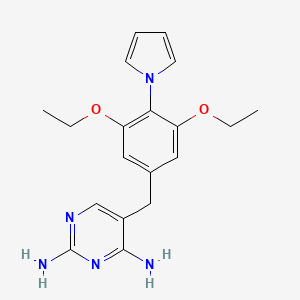
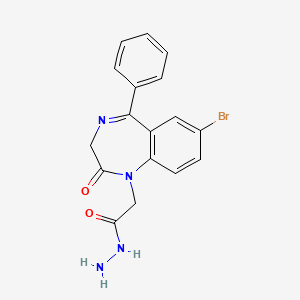
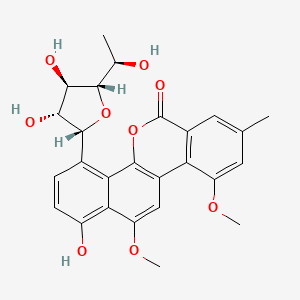
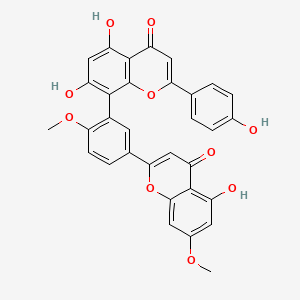
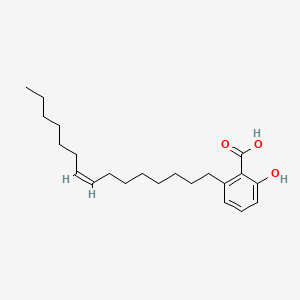
![(1R,3R,6R,7S,8S,9R,10S,11R,12S,13S,16S,17R)-8-tert-butyl-6,9,12,17-tetrahydroxy-16-methyl-2,4,14,19-tetraoxahexacyclo[8.7.2.01,11.03,7.07,11.013,17]nonadecane-5,15,18-trione](/img/structure/B1671514.png)

